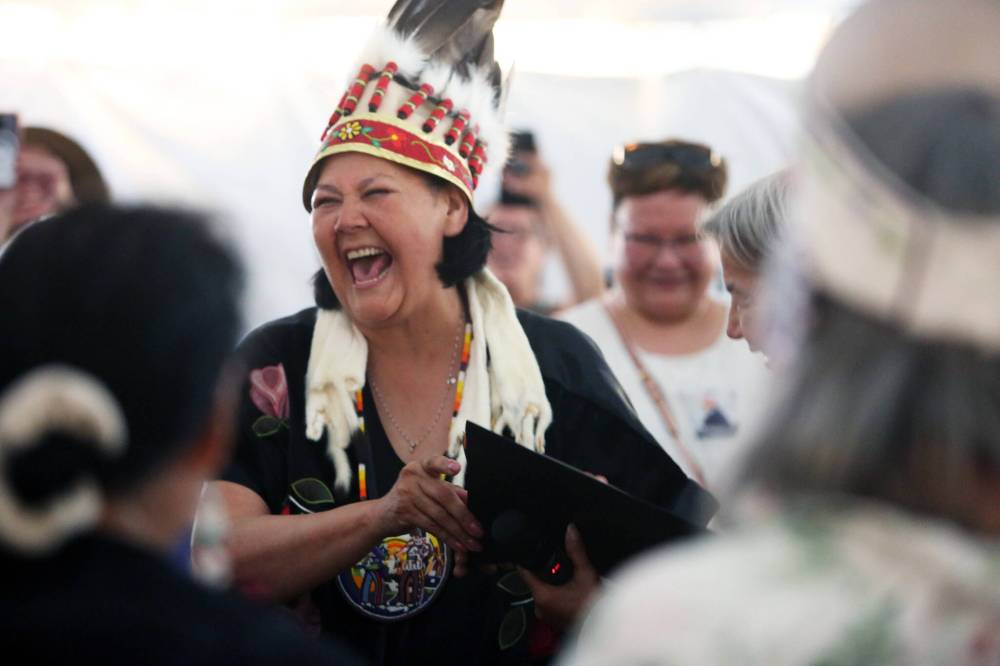In Indigenous communities, one of the primary ways an ogimaa — a chief or leader of the people — is evaluated is by asking the question: who eats last?
A strong, effective leader ensures the less strong — especially elders, children, and those who cannot feed themselves — are fed before everyone else.
A selfish, dysfunctional leader favours their family or friends, the wealthy and powerful, and leaves others to fend for themselves.

MATT GOERZEN / BRANDON SUN FILES
Assembly of Manitoba Chiefs Grand Chief Cathy Merrick takes the oath of office after being re-elected in July. Merrick died suddenly Friday.
The best leaders in Indigenous communities love their citizens unconditionally, even if the people they represent may not always love them.
This is one of the many ways Indigenous leaders come to power while ensuring the communities they work for are healthy, strong, and united.
This is how Indigenous leadership has always been.
Cathy Merrick was one such leader.
The grand chief of the Assembly of Manitoba Chiefs, who died suddenly Friday, was an ogimaa who ensured everyone was cared for first.
She was a community advocate who began her political career in 2001 as a councillor in Pimicikamak Cree Nation (also known as Cross Lake), promising to deal with the social issues in her community — specifically the way the community needed to support young families and the elderly.
She told Dennis Ward on APTN’s Face to Face she had to be convinced “many times” by her family and friends to run for leadership but knew her community’s government needed a “woman’s perspective.”
She served 12 years as councillor before running for and being elected chief of Pimicikamak in 2013 — the second female chief in the community’s history.
Being a female First Nations chief, a position long dominated by men and toxic behaviours and structures, is rare, but Merrick thrived.
She became known for declaring a state of emergency over a rash of youth suicides and built programs to increase culture and employment skills, negotiating with the federal government for the construction of a $55-million community health-care centre. She was also a fierce advocate for Indigenous rights during the Manitoba Hydro Northern Flood Agreement.
By the time she left Pimicikamak political life in 2018, Merrick was one of the most respected and well-known chiefs in Manitoba and a voice for northern First Nations.
It was no surprise she was nominated to run for AMC grand chief in 2022 after the removal of Arlen Dumas in a cloud of scandal.
Promising to advocate for First Nations control of child and family services, tackle addiction and homelessness and seek justice for murdered and missing Indigenous women and girls, she was elected the first female grand chief in the history of the 35-year-old advocacy body of 62 of 63 First Nations in Manitoba.
“I will work hard for our people,” she said in her victory speech, surrounded by First Nations women, elders, and children. “I will work hard for our nations to be represented in the assembly.”
At the time, then-Pimicikamak Cree Nation Chief David Monias supported Merrick — evidence of how beloved and honoured her work had been locally and provincially.
During her time as grand chief, Merrick rebuilt the reputation of AMC, which had been mired in allegations of a toxic workplace scandal, and began negotiations on water rights and treaty land entitlement claims for First Nations in Manitoba.
She also turned the AMC into a national advocacy body on murdered and missing Indigenous women and girls, with Merrick becoming a primary political voice demanding a search of the Prairie Green landfill for the remains of Morgan Harris and Marcedes Myran, who were slain in 2022 by a serial killer.
Her advocacy of the disenfranchised was absolute and she let nothing or no one stand in the way of her demands for change.
Merrick stood on the steps of the legislature in March to demand Wab Kinew’s government search the landfill — one of several issues she bristled with the premier on.
Her popularity increased amongst chiefs, which is somewhat rare in Manitoba First Nations politics. She was re-elected in July, securing 65 per cent of the vote.
During her time in office, she negotiated the return of Sioux Valley Dakota Nation to membership within the assembly (who had left the organization a decade earlier).
“(We returned) largely because of the leadership of Cathy Merrick,” Sioux Valley Chief Vince Tacan told media at the time.
On a personal note, I spent a lot of time with Merrick, running into her at gatherings. I will never forget the words she said to my daughter, who asked her what it was like to be grand chief.
“I’m just holding this job for young women like you,” she told her.
Merrick’s final act was to hold a media scrum outside the courthouse after corrections guard Robert Jeffrey Morden was found not guilty of criminal negligence in the death of Headingley inmate William Ahmo.
Fighting for those who need fighting for — those who needed food, medicine, love and attention — was Merrick’s life journey.
She was a brilliant, ethical and strong leader. An ogimaa. A chief.
A grand chief.
niigaan.sinclair@freepress.mb.ca

Niigaan Sinclair
Columnist
Niigaan Sinclair is Anishinaabe and is a columnist at the Winnipeg Free Press.
Our newsroom depends on a growing audience of readers to power our journalism. If you are not a paid reader, please consider becoming a subscriber.
Our newsroom depends on its audience of readers to power our journalism. Thank you for your support.